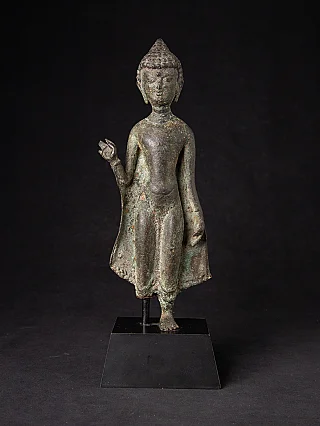Bagan period: 1044 - 1347

From 1044 to 1347, the Bagan period marks one of the most significant eras in Burmese history. It was when Bagan (also known as Pagan), one of Burma's ancient capitals, became the epicenter of Buddhist art, culture, and spirituality. The kingdom of Bagan, often called the First Burmese Kingdom, left behind a remarkable legacy, much of which is seen today in the surviving temples, pagodas, and Buddha statues that dot the landscape. This period is characterized by its impressive architectural achievements and the distinct style of its Buddha statues.
Characteristics of Bagan Buddha Statues

Buddha statues from the Bagan period are easily recognizable due to their unique features reflecting artistic mastery and deep spiritual significance. These statues stand as testaments to the devotion of the Burmese people and their sophisticated craftsmanship. Here are some of the defining characteristics:
- Facial Features: Bagan Buddha statues are known for their round faces, a distinct trait that sets them apart from Buddha statues from other periods. The expressions on these faces are often severe and stern, lacking the gentleness or warmth seen in other styles. This sternness is believed to reflect the Buddha's deep concentration and meditation, embodying the discipline and focus of the spiritual journey.
- Body Structure: The Buddha statues from the Bagan period often portray a strong, muscular physique. This robust depiction represents the strength and resilience of the Buddha's teachings and the physical and mental endurance required for spiritual enlightenment.
- The Ushnisha and Urna: Another prominent feature in Bagan Buddha statues is the ushnisha, the topknot or half-circle on the Buddha's head, symbolizing wisdom and spiritual enlightenment. In many statues from this period, the ushnisha takes a half-circle or triangular shape. The ulna, a mark on the forehead symbolizing spiritual insight, is often short in Bagan statues, further adding to the distinctiveness of these images.
- Attire: The attire of Bagan Buddha statues varies depending on the figure's posture. The Buddha is often depicted in seated Buddha statues, wearing a Sanghati (monastic robe) draped around the left shoulder. The Sanghati is worn over both shoulders for standing Buddha statues, symbolizing his spiritual authority and presence. This variation in attire highlights the attention to detail and symbolism in Bagan's art.
- Materials Used: Buddha statues from the Bagan period were crafted from various materials, including bronze, iron, sandstone, and wood. However, many of the larger Buddha images were made from bricks and plaster, particularly those housed within the pagodas. These materials were often adorned with gold leaf, creating a dazzling and radiant appearance that emphasized the Buddha's divine nature.
Bagan Buddha Statues: Materials and Craftsmanship
The artistic techniques and materials used during the Bagan period were remarkable for their time. Many statues were meticulously sculpted from bronze, a popular material for creating durable and intricate figures. Using bronze, iron, and other metals allowed artisans to craft statues with intricate details and long-lasting finishes.
Wood was also used extensively during the Bagan period, particularly for smaller Buddha images. The natural beauty of timber added warmth and texture to these statues, often paired with gold leaf to enhance their spiritual and aesthetic value. In addition to bronze and wood, sandstone was another common material. This durable stone created giant, imposing statues, particularly those in temples and pagodas.
However, bricks and plaster were the most common materials for larger Buddha images during this period. These were often used in temple construction, and the statues were integrated into the architecture, becoming a permanent feature of the sacred spaces. Many of these statues were later gilded with gold leaf, a practice that continues in Burma today.
The Significance of Bagan as a Cultural and Spiritual Hub
Bagan's importance extends beyond its Buddha statues. During the Bagan period, the city was a bustling center of religion and culture, serving as the heart of the Pagan Kingdom. At the height of its power, Bagan was home to over 10,000 Buddhist temples, pagodas, stupas, and monasteries, making it one of the most important Buddhist centers in the world. Even today, Bagan holds the largest concentration of Buddhist monuments, with over 2,000 temples and stupas still standing.
The number of temples and stupas in Bagan highlights the Burmese people's devotion to Buddhism during this period. These structures were not only places of worship but also served as important pilgrimage sites. Bagan attracted pilgrims from across Asia, and it continues to do so. Modern-day pilgrims and tourists alike visit Bagan to pay homage to the Buddha and to marvel at the architectural and artistic achievements of the period.
The Impact of Natural Disasters
While many of Bagan's temples and statues have survived the test of time, the city has also faced its share of natural disasters. The 1975 earthquake, in particular, caused significant damage to many of the temples and stupas. Restoration efforts have been ongoing, but the effects of the earthquake are still visible throughout the region. Despite this, Bagan remains a vital pilgrimage site for Buddhists and is now on the UNESCO World Heritage Site nomination list, further emphasizing its cultural and historical importance.
Share this page

































